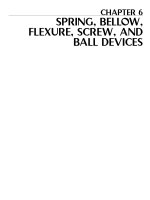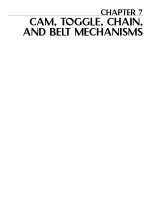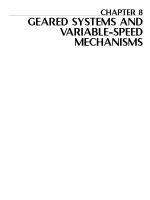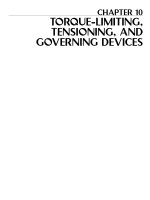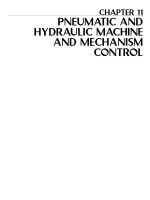C4 perforating chapter
Bạn đang xem bản rút gọn của tài liệu. Xem và tải ngay bản đầy đủ của tài liệu tại đây (1.68 MB, 40 trang )
Designed & Presented by
Mr. ĐỖ QUANG KHÁNH, HCMUT
12/2010
Đỗ Quang Khánh – HoChiMinh City University of Technology
Email: or
1
Introduction
The objective of perforating a well: to establish communication between
the wellbore and the formation by making holes through the casing,
cement and into formation in such a manner so as not to inhibit the
inflow capacity of the reservoir.
To optimise perforating efficiency, it is not solely down to the
perforating technique but relies extensively on the planning and
execution of the well completion which includes selection of the
perforated interval, fluid selection, gun selection, applied pressure
differential or underbalance, well clean-up, and perforating orientation.
Basic Perforating Methods
Basic Perforating Methods
Conventional casing guns which are run into the well on electric
wireline with or without wireline pressure control equipment.
Through-tubing guns which are run into the well after the tubing has
been installed, again via wireline pressure control equipment.
Tubing-conveyed guns which are run on the bottom of the tubing
string and detonated using mechanical, electrical, or pressureactivated firing mechanisms.
Shaped Charge
It creates a very high pressure, but a highly focussed jet that is designed to
penetrate the casing, the cement and, as far as possible, into the formation.
Components of Shaped charge
Carrier gun arrangement
Explosives
The main explosive charge is usually a desensitised RDX
(Cyclonite) type of explosive which besides being extremely powerful
in terms of the energy released per unit weight of explosive, also
reacts very quickly.
In fact, once the main charge is detonated the process is completed
after only 100 - 300 µ seconds. This fast reaction time is of
importance in that it concentrates the detonation energy of the
exploding charge to a very limited target area and also excludes any
thermal effects.
Explosive Group
Detonation process of shaped charge
The importance of using a
conical liner in a shaped
charge
Detonation process and deformation of the conical line
Detonation process of shaped charge
0 ms
4 ms
9.4 ms
16.6 ms
Detonation process of shaped charge
Perforating jet characteristic and
properties at impact with the target
Crushed zone and
compaction regions
around the perforation
tunnel
Typical Perforation
Outside of casing with small-diameter
perforation
Perforation length = 2 to 20 in (5 to 50 cm)
Entrance hole diameter = 0.2 to 1.0 in (0.5 to 2.5 cm)
Shaped charge casing
Factors affecting the crushed zone
o
(1) Size of perforation charge
o
(2) Casing wall thickness and strength
o
(3) Cement sheath thickness and strength
o
(4) Grain composition, size and shape of the formation rock
o
(5) Stress conditions in the near wellbore region
o
(6) Proximity of nearest perforations in the same vertical plane.
Factors affecting Perforation performance
The physical performance of a shaped charge is normally gauged from:
(1) Penetration length
(2) Perforation diameter
(3) Perforation hole volume
(4) Burr height on the inside of the casing around the perforation entrance hole.
Factors affecting Perforation performance
However, charge performance will be a complex matter since it will be affected by charge
size, material and configuration, the dimensions and shape of the charge case and most
importantly the characteristics of the conical liner as well as the strength characteristics of
the formation and the wellbore conditions.
(a) Gun size/explosive charge size
(b) Wellbore fluid pressure, temperature and density
(c) Gun clearance
(d) Compressive strength of formation rock
(e) Strength of casing and radial support of cement sheath
Factors affecting Perforation performance
Effect of gun size on entrance hole diameter and depth of penetration
Gun position in casing
Charge Standoff allows adequate space for the
liner to collapse and the jet to develop before it hits
the interior wall of the gun
Gun to Casing clearance negatively affects
perforation because the jet expands energy as it
travels through the completion fluid
Effect of gun clearance
Effect of rock strength
Penetration reduction produced by high compressive strength of the
formation rock
Effect of rock strength
TEST in Berea SS
target (8,000 psi):
DOP = 5 in
Smackover
sandstone target
(22,000 psi)
DOP = 1.40 in
Effect of other factors
In-situ stress: penetration is less in higher in-situ stress.
Sand grain size and distribution: penetration is less in coarse sand targets of the same
compressive strength.
Pore-saturating fluid: penetration is less in formation with gas-filled pores than in that with liquidfilled pores.
Wellbore fluid: wellbore pressure can reduce penetration 22-28% for pressure as high as 15,000
psi.
Jet quality: straight and homogenous jet penetrates deeper.
Perforation Charge Arrangement
Perforating Gun Types
Retrievable: the charges are positioned within a steel cylinder. Within the
carrier, each charge is surrounded by air at surface pressure, and is aligned
with a threaded port plug or a thinner portion of the carrier wall (scallop gun).
Semi-expendable: the charges are conveyed into the well on a retrievable metal
strip or wire carrier (used in through-tubing operations where gun size is an
important factor).
Fully expendable: the charge cases and carrier linkage disintegrate and only the
wireline is retrieved (again, used in through-tubing operations).
Perforating Guns
(a) threaded port plugs; (b) scallop gun).
Retrievable vs. Expendable
Retrievable carriers:
Advantages: Reliable, strong, P&T resistant, clean, non-damaging, indicate
firing.
Disadvantages: difficult to run, smaller charges.
Expendable carriers:
Advantages: Cheaper, light & flexible, more penetration (comparable with same
retrievable gun).
Disadvantages: damage casing, less P&T resistant.
Wireline Conveyed Casing guns
These guns are largely constrained by two factors:
(1) The gun diameter must be less than the casing
inside diameter. This allows a large diameter gun
to be used and hence large charges.
(2) The length of gun is defined by either the weight
which can safely be suspended by the wireline or
by the length of lubricator into which the gun will
be retrieved after perforating in underbalanced
conditions.



